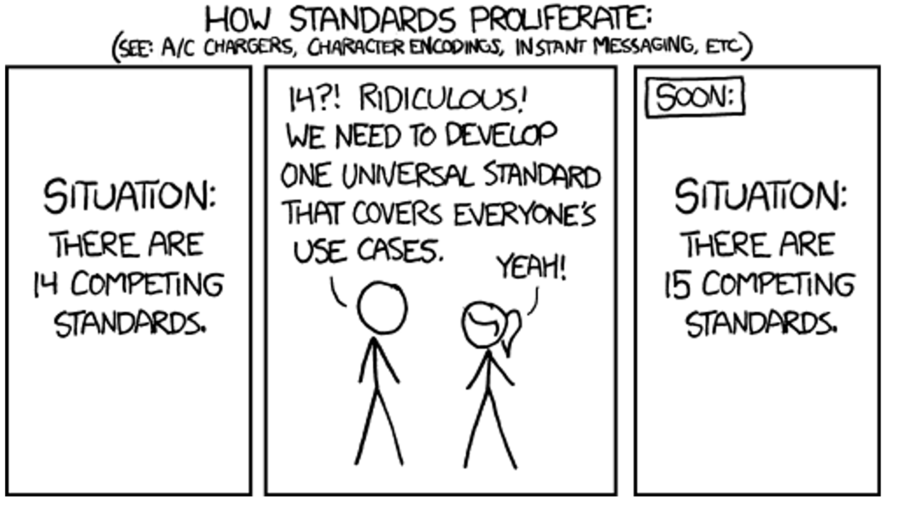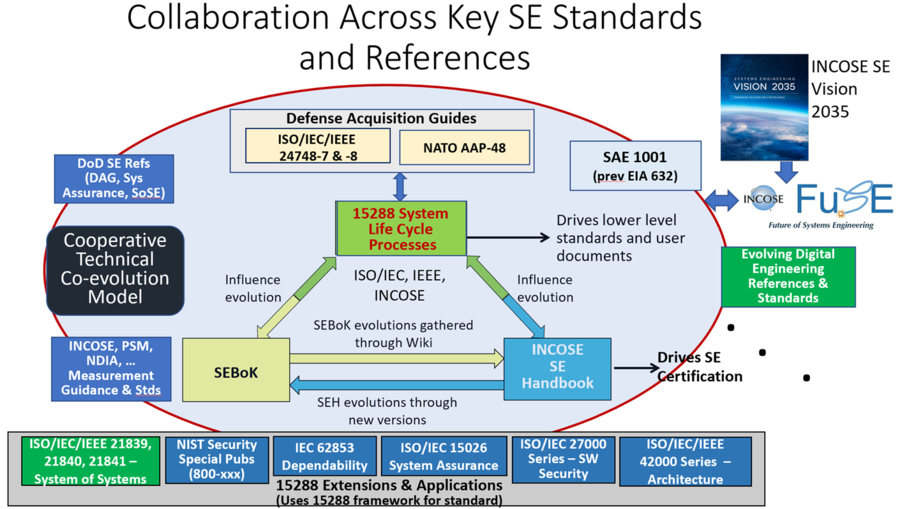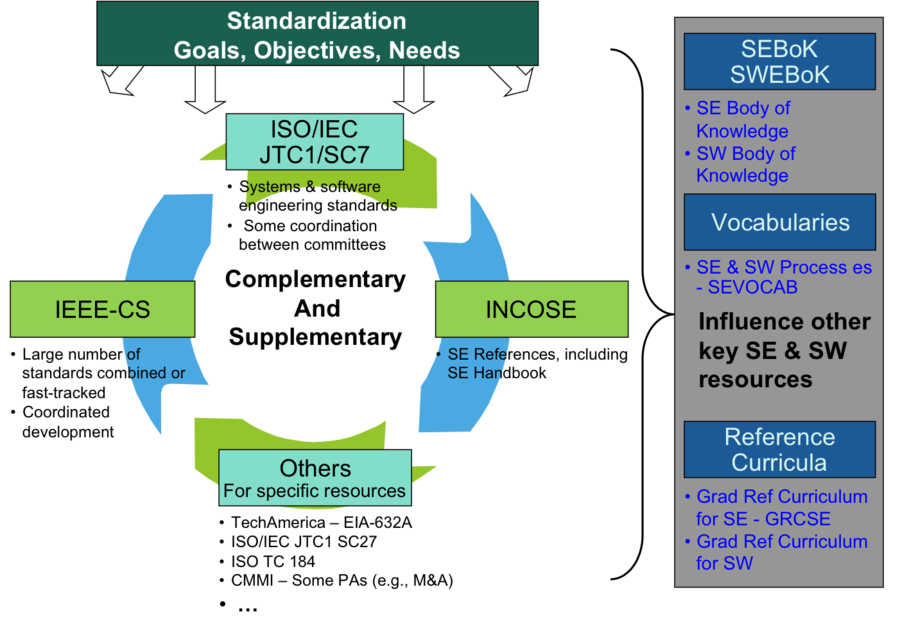Alignment and Comparison of Systems Engineering Standards
Over the past two decades, standards development organizations (SDOs) and other industry associations have been working collaboratively to align the systems engineering (SE) and software engineering (SwE) standards. The objective is to have a set of standards that can easily be used concurrently within both engineering disciplines, and eventually throughout all engineering disciplines, with common terminology and concepts.
Problem Statement
Previously, SE and SwE standards used different terminology, process sets, process structures, levels of prescription, and audiences. These differences have been both between systems and software, and to some extent, within each. The problem has been exacerbated, in whole or part, by competing standards (Roedler 2010). Additionally, new challenges emerged, such as agile, model-based, and digital approaches, as well as new technologies as the discipline continued to evolve.
If alignment efforts do not have the commitment from all of the stakeholders, especially the SDOs, it can further drive proliferation of standards, as is indicated in Figure 1.

Root Cause
The root causes of this problem include (Roedler 2010):
- Culture – Concepts such as “we’re different,” “not invented here,” etc. Culture change is complicated by the vast number of changes influencing engineering teams and environments today.
- Organizational – Structures with different SDOs, teams, committees, etc. This is further challenged by changes in team structures as agile approaches became more common. And different teams within a single organization can be implementing very different norms as the organization transitions.
- Competition – Many SDOs exist. Each SDO is motivated to have its own set of effective standards that contribute to revenue. From the perspective of other stakeholders, competition has driven significant variation in new approaches, moving away from consensus, as competing organizations, tool vendors, and consultants try to promote what they provide as differentiating for success in the industry. All of this has driven proliferation of standards over the years.
- Domains – A focused, narrow view often doesn’t look beyond the domain for commonality.
Impact
The impact of this problem includes the following (Roedler 2010):
- Less effective or efficient processes that are not focused on leveraging commonalities or lessons learned from a wider base of practitioners. This causes redundancy and has resulted in incompatibilities and inconsistencies between the standards making it difficult to use them concurrently.
- Less effective solutions that are not focused on a common approach to solve a problem or need.
- Obstacles for communicating (at all levels), working in integrated teams, and leveraging resources.
- Stove-piping due to the incompatibilities and inconsistencies of and lack of leveraging commonalities.
Objective of Alignment
The objective is to make the standards more usable together by achieving the following (Roedler 2010):
- common vocabulary
- common concepts that account for differences such as domains
- single, integrated process set
- single process structure
- jointly planned level of prescription
- suitability across multiple audiences
- inclusion of considerations in a wide range of domains and applications
- inclusion of guidance for tailoring and adaptation to account for project specific needs and differences
Alignment of Systems Engineering Standards
Approach
A collaborative effort has been in place for the past two decades that includes ISO/IEC JTC1/SC7 (Information Technology, Systems and Software Engineering), the IEEE Computer Society, the International Council on Systems Engineering (INCOSE), and others. A collaborative process is being used to align the standards. This process is built around a foundational set of vocabulary, process definition conventions, and life cycle management concepts provided in ISO/IEC/IEEE 24765 (Vocabulary), ISO/IEC/IEEE 24774 (Specification for process description), and ISO/IEC/IEEE 24748-1 (Guide to Life Cycle Management), respectively. At the heart of the approach is the alignment of ISO/IEC/IEEE 15288 (System life cycle processes) and ISO/IEC/IEEE 12207 (Software life cycle processes), which provide the top-level process framework for life cycle management of systems and software. This enables concurrent and consistent use of the standards to support both systems and software life cycle management on a single project. The approach includes the development or revision of a set of lower level supporting standards and technical reports for elaboration of specific processes, description of practices for specific purposes (e.g., systems/software assurance), description of artifacts, and guidance for the application of the standards.
Past Accomplishments
INCOSE, IEEE, ISO, and other SDOs and industry associations have collaborated to align the key SE related standards and resources to be consistent and to manage their evolution to enable concurrent usage. Figure 2 shows ISO/IEC/IEEE 15288 is at the center of this Co-evolution model (Roedler 2023). This is due to it serving as the initial basis for leveraging terminology and concepts as a baseline. As part of this alignment effort, INCOSE adopted the ISO/IEC/IEEE 15288 process set, definitions, and terminology for shaping the system life cycle process information in the INCOSE SE Handbook in 2006. As the Systems Engineering Body of Knowledge (SEBoK) started its development in 2009, the project team also adopted ISO/IEC/IEEE 15288 and the INCOSE SE Handbook as key resources for guiding its content. Each of these resources have their unique purposes and scope, but have found utility in aligning. Over time the three resources, shown as a set of three key resources in the middle of the figure, have reached a point where each influences the other. In turn, these resources have been a catalyst for alignment of the other SE related documents shown.
As part of the alignment effort, ISO/IEC JTC1/SC7 formed a Life Cycle Process Harmonization Advisory Group that evaluated the standards for systems and software engineering. The objective of the group was to provide a set of recommendations for further harmonization of the industry standards. Specifically, its charter included:
- Perform an architectural analysis and recommend a framework for an integrated set of process standards in software and systems domains.
- Making recommendations regarding the future content, structure, and relationships of ISO/IEC/IEEE 12207, ISO/IEC/IEEE 15288 and their guides, as well as other related SC7 documents.
The result of this work has been a well aligned set of system and software standards, as shown in the Taxonomy of SE Related Standards figure in the Systems Engineering Related Standards Landscapearticle.
Current Efforts
The industry continues to harmonize SE related standards and references. The collaboration has grown to include the work of the organizations and projects shown in Figures 2 and 3. These organizations are working towards the goal of completing a complementary and supplementary set of systems engineering resources that use the same terminology, principles, concepts, practices, and processes and can be used concurrently without issues.
There are some current challenges that need to be considered as the SE standards continues to evolve. These include:
- Standards have a life cycle – development, publication, review, revision, withdrawal. Where the standards are in their life cycle influences how easily they can adapt to alignment efforts.
- It is hard to achieve commonality, since it is not always easy to determine where to start the harmonization. That is, which standards become the basis for the alignment. This determines what is impacted by changes.
- After more than two decades of harmonization efforts, the industry is still struggling with standards proliferation.
- Emerging topics are not necessarily in line with the core or existing standards.
These challenges will continue to be considered and addressed to form the best set of technical references possible.
Practical Considerations
Key pitfalls and good practices related to systems engineering standards are described in the Systems Engineering Related Standards Landscape article.
There are also instances in which standards groups for program management, safety, or other disciplines create standards on topics addressed within systems engineering, but use different terminology, culture, etc. One such example is risk management, which has been dealt with by many professional societies from a number of perspectives.
Systems engineers must also be aware of the standards that govern the specialty disciplines that support systems engineering, as discussed in Part 6.
Finally, the challenges listed above under the Current Efforts are also reflective of some of the Pitfalls when trying to align the standards and references.
References
Works Cited
Roedler, G. 2023. "SE Standards and Guidance – Revisions and Trends." International Council on Systems Engineering, Boston, MA, USA.
Roedler, G. 2010. An Overview of ISO/IEC/IEEE 15288, System Life Cycle Processes. Asian Pacific Council on Systems Engineering (APCOSE) Conference.
ISO/IEC/IEEE. 2023. Systems and Software Engineering -- System life cycle processes. Geneva, Switzerland: International Organisation for Standardisation / International Electrotechnical Commissions / Institute of Electrical and Electronics Engineers. ISO/IEC/IEEE 15288:2023.
ISO/IEC. 2021. Systems and software engineering -- Life cycle management -- Specification for process description. Geneva, Switzerland: International Organisation for Standardisation/International Electrotechnical Commissions. ISO/IEC/IEEE 24774:2021.
ISO/IEC/IEEE. 2019. Systems and Software Engineering - Vocabulary (SEVocab). Geneva, Switzerland: International Organization for Standardization (ISO)/International Electrotechnical Commission (IEC)/ Institute of Electrical and Electronics Engineers (IEEE). ISO/IEC/IEEE 24765:2019.
ISO/IEC/IEEE. 2024. "Systems and Software Engineering -- Life Cycle Management – Part 1: Guidelines for life cycle management,". Geneva, Switzerland: International Organization for Standardization (ISO)/International Electrotechnical Commission (IEC)/ Institute of Electrical and Electronics Engineers (IEEE). ISO/IEC/IEEE 24748-1:2024.
ISO/IEEE. 2017. Systems and Software Engineering — Software Life Cycle Processes. Geneva, Switzerland: International Organization for Standards (ISO)/Institute of Electrical & Electronics Engineers (IEEE) Computer Society, ISO/IEEE 12207:2017.
Roedler, G. 2011. "Towards Integrated Systems and Software Engineering Standards." National Defense Industrial Association (NDIA) Conference, San Diego, CA, USA.
Proliferation of Standards figure: http://xkcd.com/927/
Primary References
Roedler, G. 2010. "An Overview of ISO/IEC/IEEE 15288, System Life Cycle Processes." Asian Pacific Council on Systems Engineering (APCOSE) Conference.
Roedler, G. 2023. "SE Standards and Guidance – Revisions and Trends." International Council on Systems Engineering, Boston, MA, USA.
Roedler, G. 2011. "Towards Integrated Systems and Software Engineering Standards." National Defense Industrial Association (NDIA) Conference, San Diego, CA, USA.
INCOSE. 2023. INCOSE Systems Engineering Handbook 5th Edition. International Council on Systems Engineering. Hoboken, NJ, USA: John Wiley & Sons. INCOSE SE Handbook.
ISO/IEC/IEEE. 2023. Systems and Software Engineering -- System life cycle processes. Geneva, Switzerland: International Organisation for Standardisation / International Electrotechnical Commissions / Institute of Electrical and Electronics Engineers. ISO/IEC/IEEE 15288:2023.
ISO/IEC. 2021. Systems and software engineering -- Life cycle management -- Specification for process description. Geneva, Switzerland: International Organisation for Standardisation/International Electrotechnical Commissions. ISO/IEC/IEEE 24774:2021.
ISO/IEC/IEEE. 2019. Systems and Software Engineering - Vocabulary (SEVocab). Geneva, Switzerland: International Organization for Standardization (ISO)/International Electrotechnical Commission (IEC)/ Institute of Electrical and Electronics Engineers (IEEE). ISO/IEC/IEEE 24765:2019.
ISO/IEC/IEEE. 2024. "Systems and Software Engineering -- Life Cycle Management – Part 1: Guidelines for life cycle management,". Geneva, Switzerland: International Organization for Standardization (ISO)/International Electrotechnical Commission (IEC)/ Institute of Electrical and Electronics Engineers (IEEE). ISO/IEC/IEEE 24748-1:2024.
ISO/IEC/IEEE. 2024. Systems and Software Engineering -- Life Cycle Management – Part 2: Guidelines for the application of ISO/IEC/IEEE 15288 (system life cycle processes). Geneva, Switzerland: International Organisation for Standardisation / International Electrotechnical Commissions / Institute of Electrical and Electronics Engineers. ISO/IEC/IEEE 24748-2:2024.
NATO. 2022. NATO System Life Cycle Processes. Brussels, Belgium: North Atlantic Treaty Organization (NATO). NATO AAP-48.
SAE. 2018. Integrated Project Processes for Engineering a System. Warrendale, PA, USA: SAE International. SAE 1001.
Additional References
INCOSE. 2022. Systems Engineering Vision 2035: Engineering Solutions for a Better World. San Diego, CA, USA: International Council on Systems Engineering (INCOSE). INCOSE SE Vision 2035. 2022.

